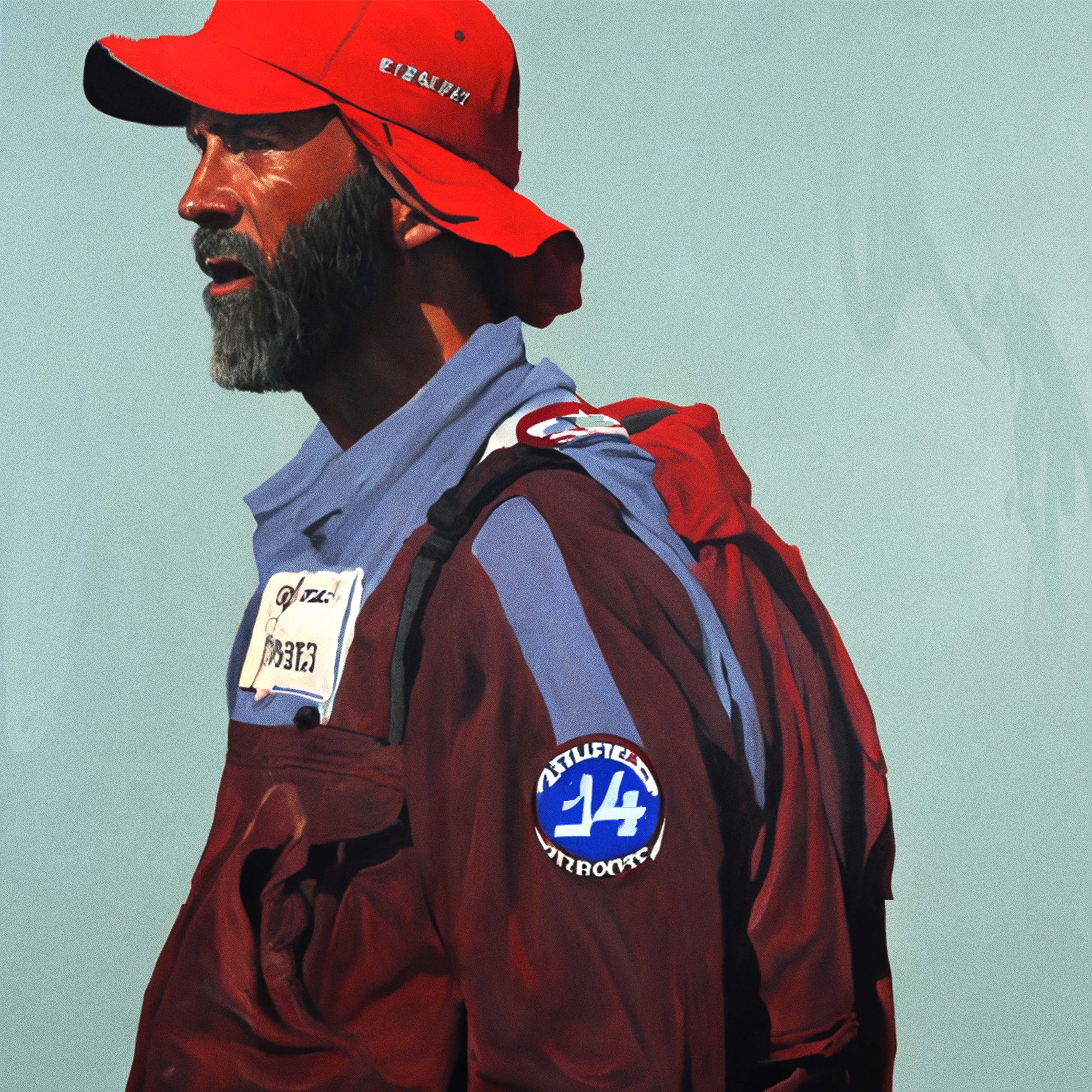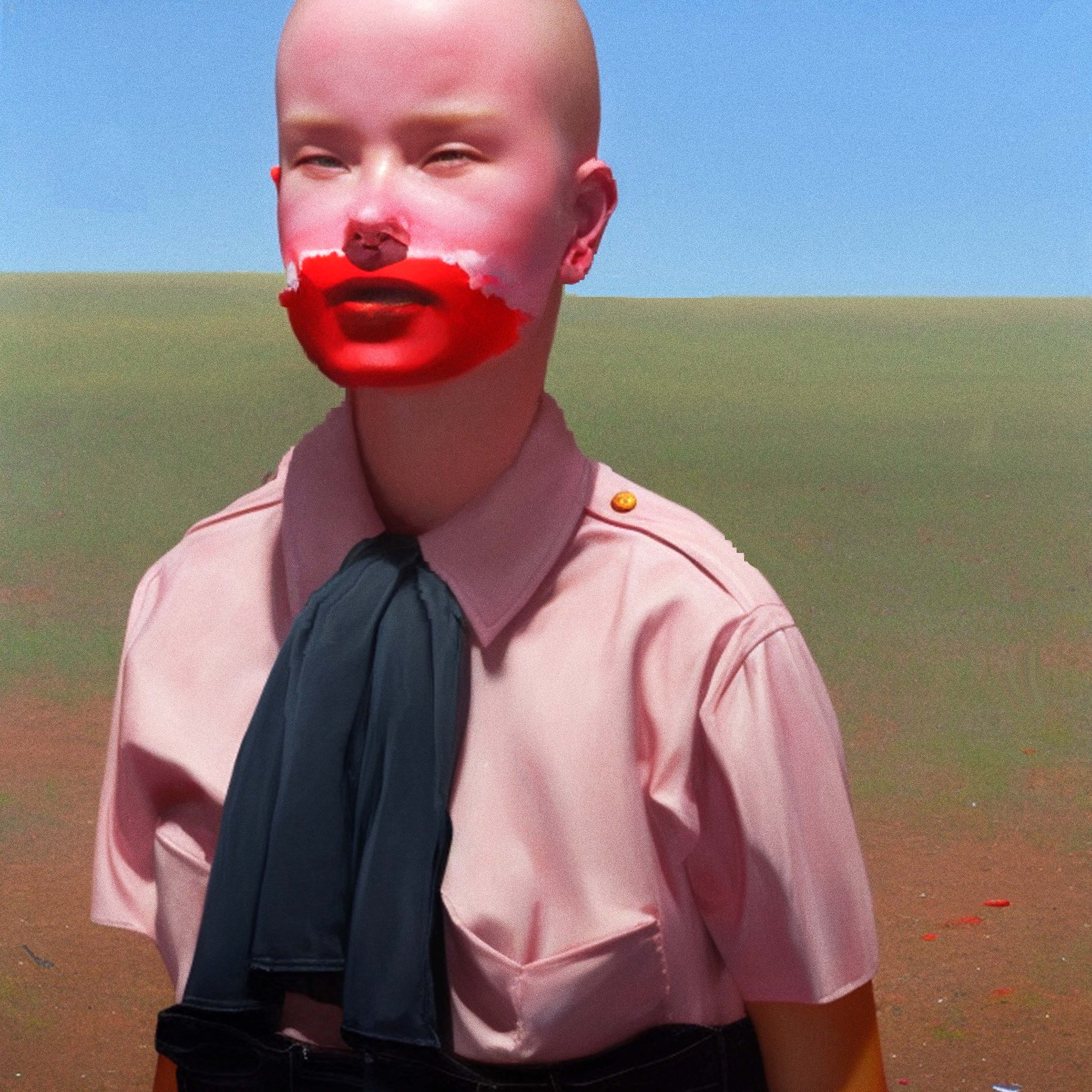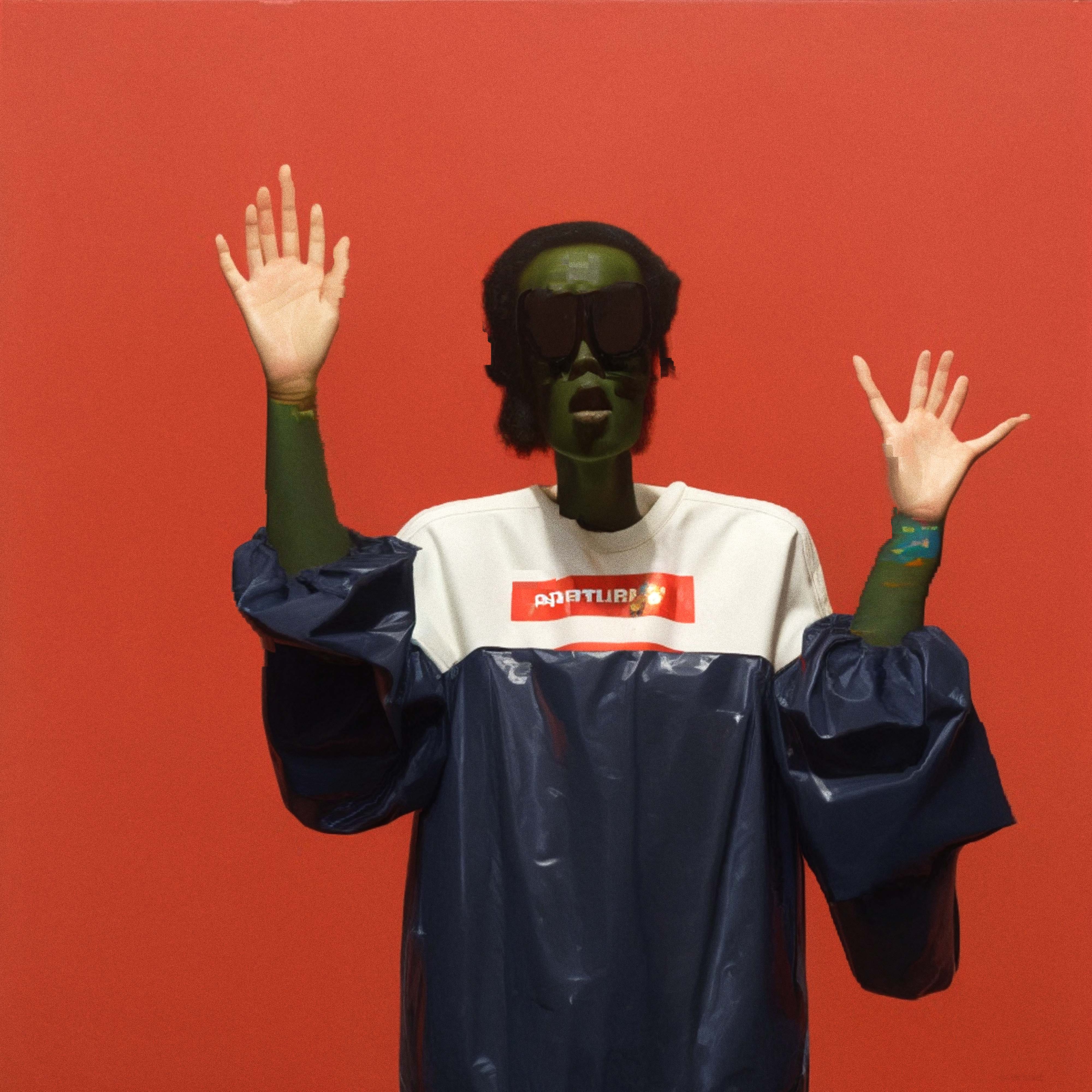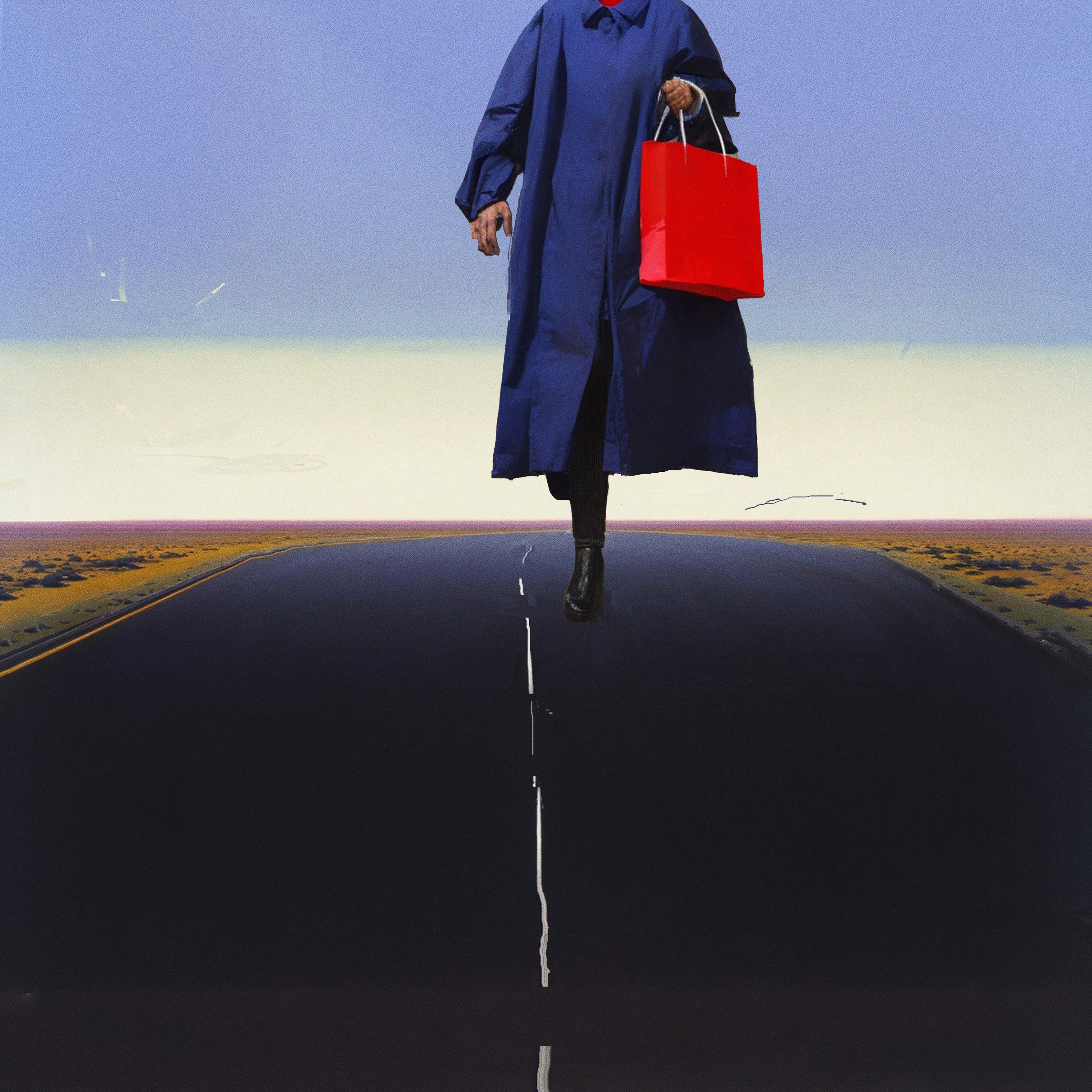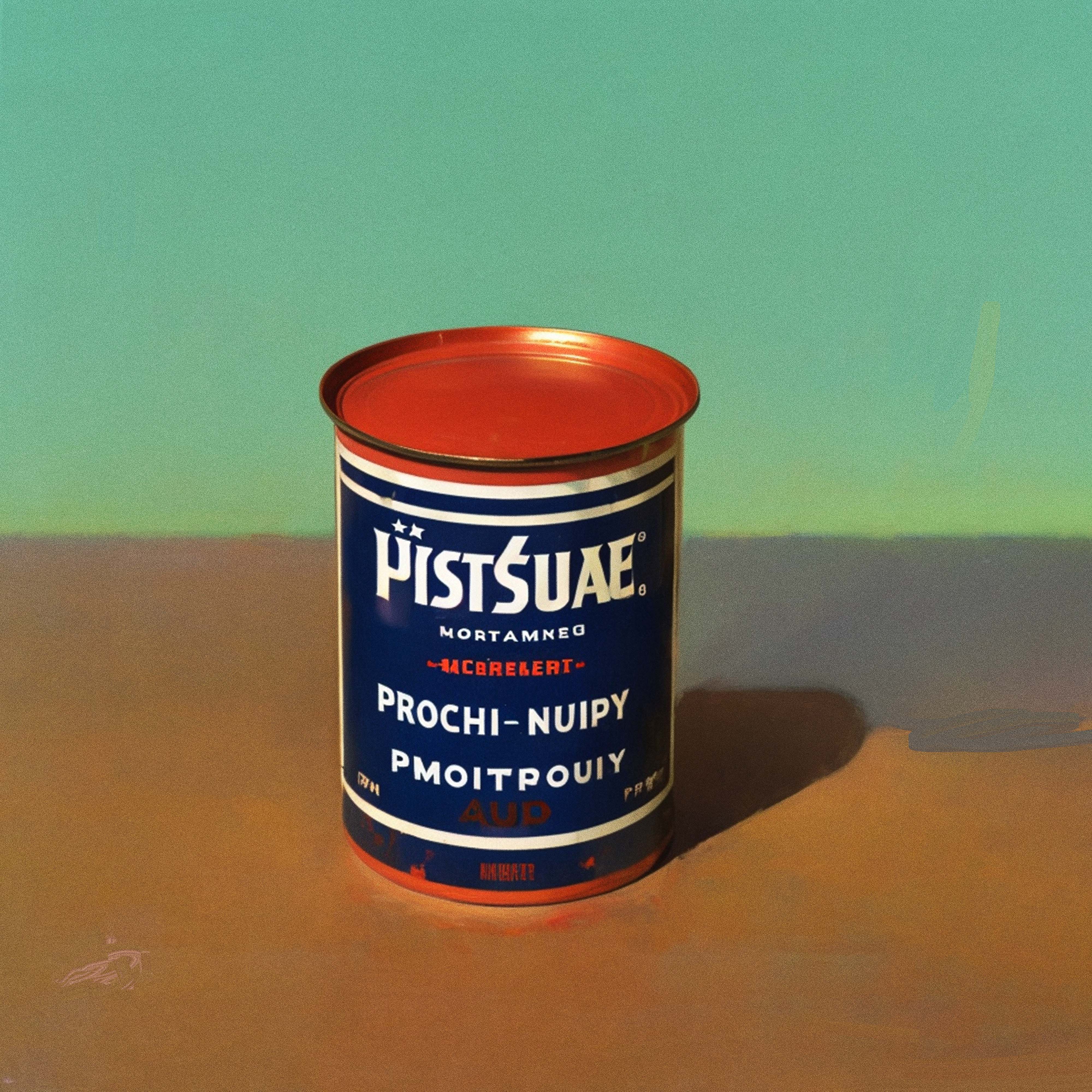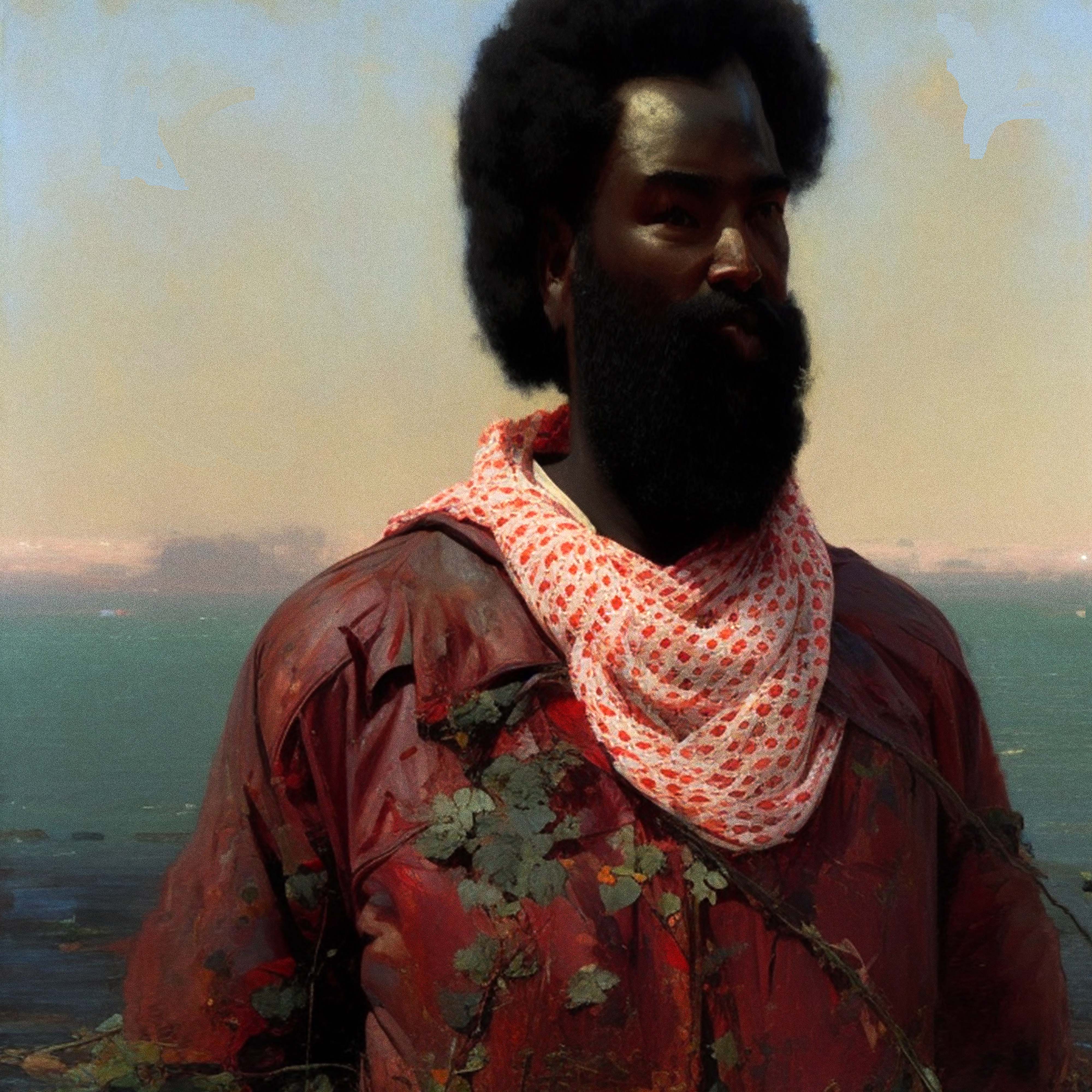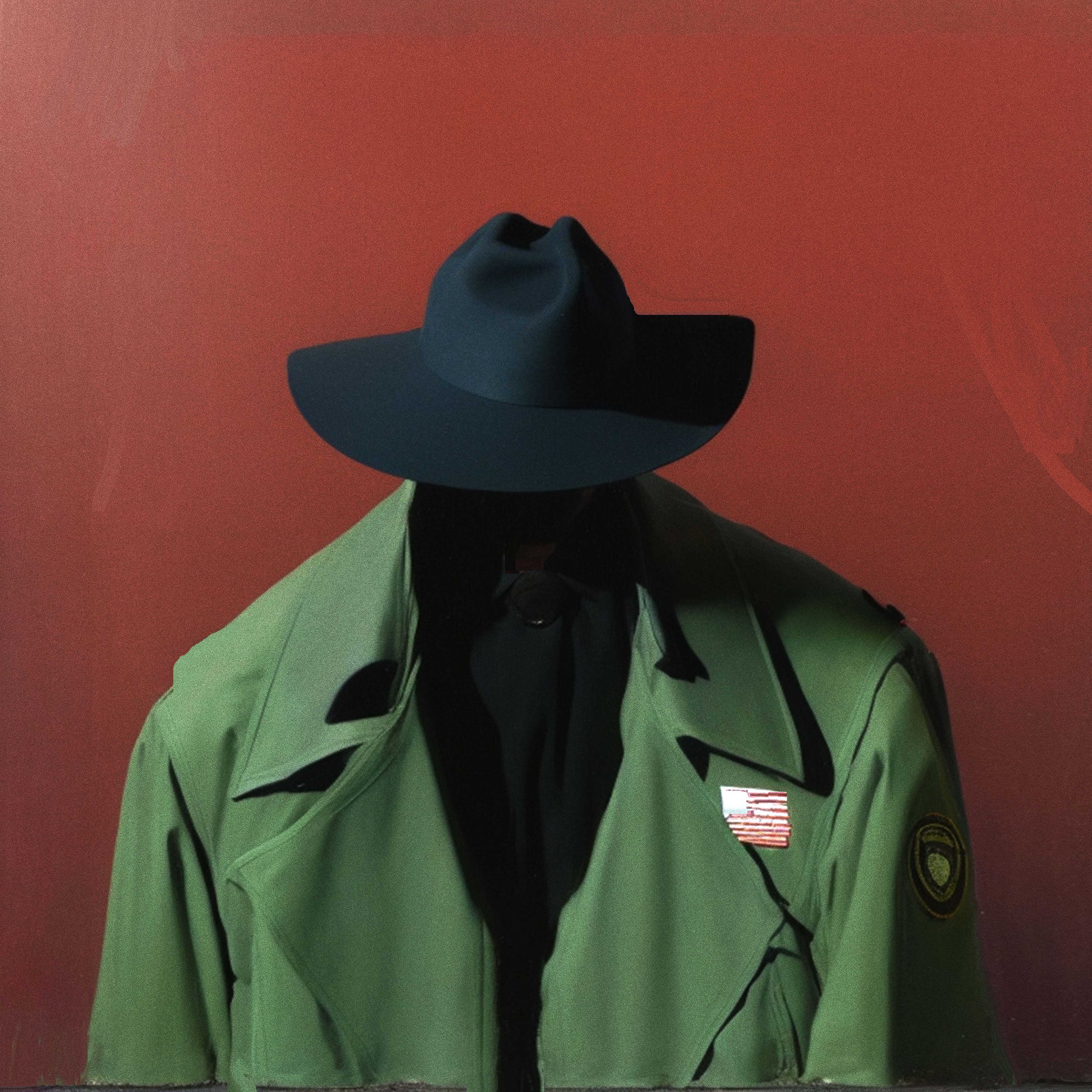Day 5: Various Artists
'Post Photographic Perspectives II: Acceptable Realities', showcases 1,200 unique AI-generated post photography and 255 post video artworks. This collection, brought together by Fellowship in collaboration with a diverse group of artists, collectors, and curators, traces the evolution of this innovative medium situated at the intersection of AI and Photography. Below are previews from the 10 artists on Day 5.
Alkan Avcıoğlu
Overpopulated Symphonies
I am a polymath deeply immersed in the world of art. With a Master's degree in Film Studies and a PhD in Communication Sciences, my journey has been intertwined with artistic endeavors. As a former film critic and DJ, my life has revolved around various forms of artistic expression. Countless hours have been dedicated to studying and delving into art theories, shaping my artistic vision.
"Overpopulated Symphonies" is a collection of AI post-photography that immerses viewers in a commentary on the contemporary human condition. Through sprawling images of densely populated urban landscapes and human gatherings, the collection reduces individuals to minuscule points, forming an overwhelming sea of indistinguishable dots.
Beyond the literal portrayal of overpopulation, this collection utilizes the metaphor of crowd density as an analogy for the inundation of information in our modern era. It poses questions about identity, individuality, and the struggles faced by the human mind in processing and prioritizing the relentless surge of data we encounter daily. The figures in these photographs transcend mere physical bodies; they represent thoughts, ideas, and information, all vying for recognition and space within the confines of our mental landscapes. With humans depicted as dots in a chaotic neural network, these artworks serve as an allegory for the phenomenon of information overload.
The title "Overpopulated Symphonies" intends to evoke the intricate and often overwhelming nature of our current reality. "Overpopulated" alludes to the physical density of human gatherings depicted in the collection, but also metaphorically refers to the overflow of information and ideas that bombard us incessantly. The term "Symphonies" suggests a sense of harmony and order, offering an optimistic counterpoint to the chaos portrayed. It hints at the potential for synchronicity to arise from apparent disarray.
Alice Gordon
Cognitive Behaviour
“Cognitive Behavior” offers a glimpse into my interpretation of the psychological state of humanity, while also drawing a connection to my personal therapy sessions. My creative process is a fusion of experimentation and spontaneity. I initiate each artwork with a conceptual or emotional text, which I then transform into an absurd visual narrative. I repeat this process until the narrative unveils an unexpected facet of the human psyche.
Both classical and modern art have lost their ability to reflect the psychology of newer generations. The anxieties, insecurities, underlying tension, alienation, and mental fatigue experienced behind the scenes necessitate a new artistic grammar. My aim is to discover a fresh visual strategy and vocabulary that can effectively convey these tensions and accurately reflect the psyche of the new generation. I refer to my style as "absurdist surreal lonerism," as I believe the key to this lies within the realm of absurd stillness.
Depression, anxiety, panic, and other mental health issues have undergone rapid transformations in meaning within the information age, deeply intertwining themselves within our daily lives. The conventional modes of artistic expression for these matters have become obsolete. To adequately represent these issues, we must venture into uncharted territories within surrealism. By blending post-photography using AI tools with neo-surrealism, we lay a strong foundation for this exploration.
Spanning from minimalist symmetrical compositions to awkward surreal chaos, my collection employs a visual strategy that invokes the absurd. The constant bombardment of stimuli in contemporary life has left individuals feeling dull, numbed, and void. Through a visual style that captures this inherent tension and anxiety through absurd dullness, I aim to reveal unpredictable, awkward realms and unexplored territories.
I utilize Midjourney and have faith in the power of raw AI outputs. I refrain from extensive editing and only upscale the generated images. My process primarily revolves around iteration and contemplation. I generate numerous variations of an image I find appealing, and reaching a version that satisfies me becomes a lengthy, arduous and fulfilling journey.
Alina Trifan
AI-Log
“AI-Log” is an immersive project that explores the realms of memory, place, and the allure of the apocalypse. Its genesis lies in a captivating dialogue between myself and AI, a journey of mutual understanding and shared perspectives.
The collection interweaves photographs sourced from various years and countries that I, as an immigrant, have called home. The resulting compositions resonate with a nostalgic undercurrent, evoking both the sentiments of bygone eras and the interconnections of our present reality. “AI-Log” unfurls like a diary, with entries that oscillate between personal anecdotes and contemplations on universal themes, notably the elusive nature of memory. Through this process, I have not only revisited past experiences but also forged new ones.
An unexpected facet of “AI-Log” manifests as a chronicle of events preceding the apocalypse. This element emerged organically during my interactions with AI, perhaps influenced by my state of mind or the melodies that serenaded me. While the imagery often alludes to disintegration and decay within nature, there remains an exaltation of beauty and a profound sense of curiosity for what may lie beyond. This sentiment is particularly palpable in the depictions of human figures who valiantly confront destruction with open arms.
To commence the creative process, I meticulously organized my extensive archive of photographs into categorized folders, considering factors such as year, location, subject matter (nature, people), and a particularly evocative folder entitled "Magic," housing images that exude a textural quality capable of imbuing the final compositions with an air of enchantment.
Guided by intuition and a desire to generate fresh narratives, I carefully selected pairs of photographs. Employing the capabilities of AI models, I harmoniously blended these visual counterparts, occasionally augmenting the process with textual prompts to achieve the desired outcome. After numerous iterations and variations, I amassed over 2000 images, each a testament to our collaborative journey.
Beth Frey
Sentient Muppet Factory
I am a Canadian artist working across various mediums, including drawing, painting, video, and sculpture. My artistic practice humorously exposes contradictions within subjects such as gender, the body, social media, mental health, and spirituality. Often featuring representations of myself, my works are set within colorful and cartoon-like worlds.
My exploration into the intersection of photography and AI began with early AI generators such as VQGAN+CLIP and NightCafe's "artistic" mode. As a painter, I was captivated by the results that skillfully balanced the figurative and the abstract - an aesthetic I often strive for as an artist. When I first experimented with DALL-E last summer, I was initially put off by its seemingly flawless output. However, as I discovered ways to harness its potential in the creation of a series of absurdist film stills, I became hooked. This experience gave birth to my project titled "Sentient Muppet Factory."
Inspiration for the project stemmed from a talk I attended by Laurie Anderson, who used puppets as an analogy for new technologies. Imagining my AI-generated images as part of a late 1970s variety show, I began to develop the concept of “Sentient Muppet Factory.” Although the title humorously references AI discourse - as these muppets are not truly sentient - the term "factory" speaks to the mechanized production facilitated by AI, as I churn out new characters in a seemingly automated manner.
All the pieces in this series were generated using a bank of images stored on my computer, primarily consisting of the early NightCafe pieces, along with a few photos of myself in my studio. Purposefully utilizing disparate source imagery from the text prompts, I aimed to provoke an unsettling result, intentionally confusing the AI into responding in unconventional ways.
Felipe Posada
String Theory (Beyond the Edge of Reality)
My artistic practice embarks on an odyssey through the ethereal expanse of the Invisible Realm—a boundless space where intuition, memories, visions, and dreams converge to assume tangible visual form. Within this domain, “String Theory” emerges as a quantum plunge into a terrain I once identified as “The Edge of Reality.” Comprising ten narratives situated in an ostensibly divergent era, “String Theory” beckons us to dismantle our perception of reality, unraveling it into ethereal strands of color that resemble an infinite tapestry woven by the very fabric of our sensory encounters.
My creative process germinated years ago with “The Edge of Reality,” an exploration that entailed the creation of digital collages meticulously crafted from vintage postcards. Once the foundational composition is established, I embark on the laborious undertaking of manually stretching select areas of the image, transmogrifying them into delicate tendrils of elongated pixels. These vivid pixel strands are fastidiously chosen and orchestrated to confer equilibrium upon the compositions without compromising the essence of the subjects they envelop.
Through this project, I sought to depict a diverse array of scenarios where subjects and environments were deconstructed into ephemeral strands of texture and color, reminiscent of an imperceptible barcode—an encrypted language of the unseen. Through this process, I worked to decode our collective perception of reality, rearranging its constituent elements in a novel fashion. However, as I commenced my collaboration with AI, I encountered instances where subjects were disassembled and rearranged into an array of heterogeneous, and at times repetitive, patterns. This exploration resonates with the very appellation of the series, drawing inspiration from the homonymous principle in quantum mechanics. “String Theory” postulates the existence of multiple realities within an infinite matrix, where the passage of time eludes linearity.
Graphica
Once upon the time in C:\Users\Admin\Pictures
I am Graphica, a juxtaposer of uncanny ideas, navigating the realm between reality and the hidden recesses of your oldest copy/paste JPEG folder. While my focus primarily lies in the realms of hand-drawn painting and illustration, my creative endeavors have recently delved into the realm of AI, collaborating to explore the almost-present, the bygone eras, and the possibly forthcoming.
My work centers around the reimagining of antiquated and kitschy advertisements, internet graphics, and prehistoric memes, and transforming them into nostalgic voyages. I am a visionary of parody or perhaps a parody of a visionary. Through my work, I offer punchlines without accompanying jokes, a metamorphosis of banal daily existence and overanalyzing thoughts into evocative imagery.
The folder "C:\Users\Admin\Pictures" holds a peculiar fascination for me, despite never having utilized it prior to my foray into PC-based work. Perhaps it holds something sacred or significant that one would preserve, or perhaps it is a repository of accidental clutter. It feels akin to Pandora's Box of JPEGs, its contents an enigma waiting to be discovered.
While I often commence with a specific point or generated piece in mind, I immerse myself genuinely in existing images, news, and regenerated materials from past projects. With AI specifically, my creative process embraces delightfully cheesy elements that come from prompts, and I use these as starting points to build up the work to translate experiences and memories through collage form. My primary objective lies in reflecting upon anything—history, the present, matters of the heart, or the complexities of the mind.
Though I cherish my work, I prefer to advocate for it solely within the confines of my mind. Many aspects remain concealed behind the proverbial curtain, only to be later reimagined or revisited when older materials find renewed relevance in the present moment.
Iñigo Bilbao
Fluxus
In 1963, Nam June Paik (1932 - 2006), a video artist associated with the Fluxus movement, provocatively placed a real cow's head at the entrance of one of her exhibitions. The head jolted visitors out of their perceptual lethargy, transporting them into an altered state of consciousness, and enabling them to engage with the exhibited works with a renewed vision. Inspired by Paik’s gesture, I seek to imbue this project, “Fluxus” with a similar function by subjecting myself, the AI, and the viewer to a cathartic shock.
Once upon a time, I harbored a recurring dream in which I tirelessly searched for a mysterious object—a book, a box, or some enigmatic device—that promised boundless inspiration and artistic creativity. Today, thanks to AI, my dream has manifested into reality, although it possesses the potential to metamorphose into a nightmarish realm. I venture into "The Zone," an infinite expanse that unveils a distinct reality for each visitor. In my case, it materializes as a realm steeped in darkness and disquietude. I contemplate whether the imagery I encounter reflects the depths of my own troubled subconscious or resonates with a collective unconsciousness. Regardless, my affection for what I behold remains unwavering.
Typically, my images emerge as unfiltered outputs, rarely subject to modification or retouching, save for the occasional blemish or border adjustment. Respecting the vision and imprint of the algorithm is paramount to me; its errors often unveil unforeseen triumphs. I derive satisfaction from perceiving myself not as the creator of these images, but rather as a documenter, capturing what lies within the depths of the enigmatic black box. It is as if what I witness has perpetually existed, awaiting my discovery.
Within this project, my aim is to subject the algorithm to a form of shock therapy. Through the utilization of extensive prompts comprising nonsensical words and phrases, I compel the AI to freely navigate uncharted territories, continually surprising me with its responses.
Jacqui Kenny
Moments of Argleton Lane
I was born in New Zealand in the 1970s. My passion for the convergence of photography and technology blossomed while working as a director's assistant at a film production company in the early 2000s. I went on to establish the digital arm of the company, and explored the transformative impact of mobile phones on filmmaking.
In 2016, I started the "@streetview.portraits" project on Instagram—a personal escape from anxiety and agoraphobia. It consists of ethereal screenshots captured from remote locations in Google Street View, serving as the foundation for my subsequent endeavors.
"Moments of Argleton Lane" represents more than a project; it embodies my journey of self-discovery and liberation from anxiety and agoraphobia. I could be perceived as a post-photographer, curator, storyteller, or a guide to an alternate realm discovered in my search for solace. As I delved into Google Street View, I encountered temporal glitches and visual anomalies that hinted at an existing, alternative world separate from the one I created.
This ethereal realm materialized as 'Argleton Lane,' a phantom town that appeared on Google Maps in the 2000s. It may have been a 'trap street' inserted by mapmakers to protect their copyright. The series "Moments of Argleton Lane" is the latest chapter of a larger series, following the debut of "Homes of Argleton Lane" and "Flora of Argleton Lane" as part of Obscura’s The World Today NFT collection. Throughout all this work, I question whether the peculiarities I encounter are mere errors or a profound force at play.
My creation process involves using prompt engineering with models like Midjourney and Dall-E 2, and trained with my Google Street View database. Simple and open-ended prompts inspired by my encounters during "@streetview.portraits" are iterated to achieve the desired outcome through curation. Minimal post-production is done using Dall-E 2 or Photoshop. Each collection within the “Argleton Lane” series showcases the prevailing AI technology of its time, documenting the evolution of AI-based image creation.
Nathan Boey
Unmoored
Throughout my life, I have explored various artistic mediums, from childhood drawings to adolescent forays into design, sculpture, and video. However, it is in the realm of still and moving images that I have dedicated the past two decades of my creative journey.
“Unmoored” seeks to challenge viewers by presenting familiar objects, locations, and tones in unexpected pairings. Drawing upon mundane characters, objects, and settings inspired by personal memories and life experiences, the work displaces these elements from their usual contexts, and challenges viewers to venture beyond the surfaces of the images to find new associations and deeper understandings.
The creation of each image in “Unmoored” entailed equal measures of memory, imagination, and emotion. Each studio session commenced with compiling a list of people (their professions, ages, and attire), settings/locations (specific eras and times of day), and other elements (inanimate objects, animals, etc.), all drawn from fragments within the artist's memory.
Armed with a list containing approximately ten ideas from each category, I would begin piecing them together, considering both their visual qualities and the emotions they stirred within. Whenever a moment struck me with resonance, I would delve into Midjourney and commence the process of prompting. On average, it would take 40 to 100 iterations to unearth something that resonated profoundly with my vision. And in pursuit of a purity in AI art making, I refrained from retouching any of the outputs beyond upscaling the completed works.
Ultimately, “Unmoored” reflects on the intoxicating allure of those moments when inspiration struck—a sensation akin to a drug that has captivated me since my youth. This feeling, characterized by the stimulation of entirely new neural pathways within the brain, serves as the driving force behind my creative pursuits. Striving to evoke this electrifying sensation, I endeavor to forge unexplored realms of perception and experience through my work.
Synchrodogs
Overture
We are Synchrodogs, a dynamic duo of fine artists hailing from Ukraine. Collaborating since 2008, our creative journey began in the realm of photography, but as artists with a strong background and education in technology, we gradually transitioned into the realm of mixed media. Our ambitions extend beyond the confines of art itself, as we aspire to effect meaningful global change. Our endeavors thrive on visionary thinking, ceaselessly generating captivating concepts while keeping our sights set on monumental goals.
The word "Overture" carries a rich history in the realms of art and music, typically associated with classical and traditional forms. However, beyond its connotation as the introduction to an opera or play, it possesses an additional meaning—a prelude to something of greater substance.
The era we inhabit serves merely as an overture to what lies ahead. Presently, we witness the nascent stages of AI gradually unfolding and aiding humanity, whether in mundane daily tasks or in unraveling the planet's most intricate mysteries and challenges. We have merely glimpsed a small fragment of the imminent Future, which forms the core message of "Overture" itself.
“Overture” is produced through a complex process that utilizes four distinct AI tools, and stems from training AI on our own vast 15-year archive of cinematic photography to become an entirely new artistic creation utilizing neural networks. This amalgamation remains a natural extension of Synchrodogs' oeuvre, rather than a fusion of disparate and incongruous styles.
Visually, "Overture" embodies the convergence of human and technological realms. Through the implementation of AI tools, our objective is to juxtapose classic and familiar techniques with progressive and innovative approaches, and each piece in the collection is meticulously crafted by blending together multiple works captured originally on medium format film. The resulting project exclusively draws upon 15 years of our fine art practice, transitioning from classic analog photography to an innovative interpretation through neural networks.


















































